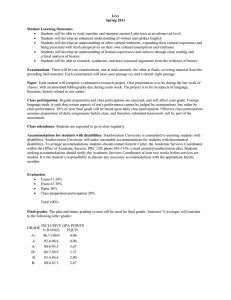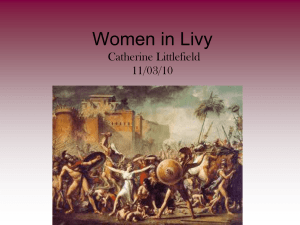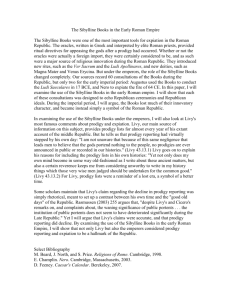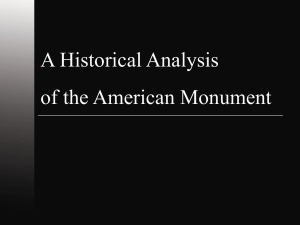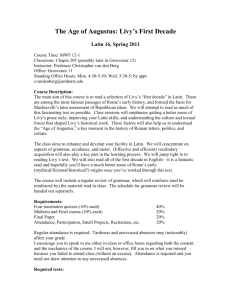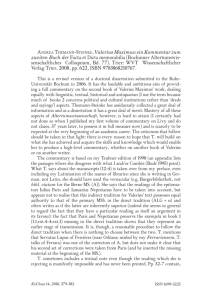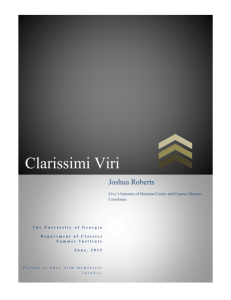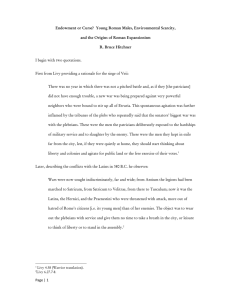Monuments
advertisement
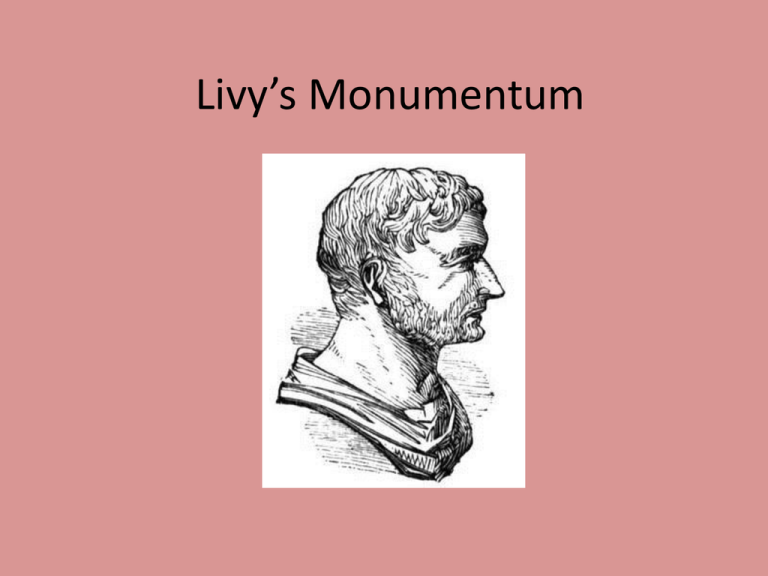
Livy’s Monumentum
(Lewis & Short)
mŏnŭmentum (mŏnĭm- ), i, n. [moneo),
I. [select] that which preserves the remembrance
of any thing, a memorial, a monument; esp. of
buildings, statues, galleries, tombs erected to
perpetuate the remembrance of a person or
thing; cf. Paul. ex Fest. p. 139 Müll.
Ancient Authors use the term
• Varro (1st Cent B.C.): Physical reminders in the
present day, of the past, which teach a lesson.
His examples are graves and their inscriptions
that advise the living. (Varro De Lingua Latina
6.49)
• Otherwise mentioned and discussed by Cato
(fr. 83P), Suetonius (Tib.2.1-2), Pliny the Elder
(NH 21.6), Ovid and Cicero.
Jaeger (1997):
A physical thing or delineated space, distinguished with the intent of carrying some
message into the future. Monumenta are a “Janus-like” phenomena which look both
into the past as well as the future; immortalizing past events and preserving an
important Lesson or Value for the future. Monumenta have some common
characteristics.
–
–
–
–
An absent person or thing commemorated.
A present audience reminded.
A memory or an exhortation that is socially relevant
A meaning determined jointly by the reminder, its physical context and the circumstances of each
viewer.
Miles (1995):
Monuments were survivals from the past for which they provide evidence. Livy explicitly
refers to them as incorruptus, but tacitly points admits that they are also susceptible
distortion. His supposed unbroken link with the past available for inspection in three
forms:
(1)the intentional
(2)the unintentional
(3)the literary
Wiseman (1986)
The foundations of aetiological stories, used as a physical
validation of the truth of historians writing. Monumenta
spawn fabulae.
• These were especially important before the Samnite Wars.
• Stories based off of interpreting monumenta, were not
necessarily true. Livy (38.56.2)
Bonfante (1998):
Monuments are the physical survival of memory. The
visual/physical world of Rome is the embodiment of its
traditions. Livy in specific sees monuments as large
architectural objects, as well as literary works which are
described metaphorically as architectural objects.
What is a Monumentum?
Past
Future
MONUMENTUM LIVII
Occurances of Monumentum in Livy
7
6
5
4
3
2
1
{
0
2/3
Praef (6), Praef (10),1.12, 1.13,1 1.36, 1.45, 1.48, 1.55, 2.33,
2.40, 4.7, 4.10, 4.16, 4.24, 5.30, 5.52, 6.1, 6.20, 6.28, 6.29, 7.21,
7.3, 8.11, 8.40, 9.18, 10.15, 10.2, 23.20, 25.39, 26.24, 26.41,
29.37, 30.28, 31.30, 31.29, 37.6, 31.30, 31.29, 37.6, 38.56 (4x),
38.57, 38.53, 39.37, 39.40, 45.27
Type 1: The Constructed Monument
• Non inviderunt laude sua mulieribus viri Romani—adeo
sine obtrectatione gloriae alienae vivebatur— [12] ,
monumentoque quod esset, templum Fortunae muliebri
aedificatum dedicatumque est. (2.40.11-12)
“The Roman men did not begrudge the women due regard
– truly it survived without the detraction of foreign
praise, so that it would be a reminder (literally a
monument), a temple was built and dedicated to Lady
Fortuna.”
• Other examples: 1.36, 1.55, 2.33, 2.40, 5.30
Type 2: Monumentalized Space
• [7] foedum inhumanumque inde traditur
scelus, monumentoque locus est. Sceleratum
vicum vocant. (1.48.7)
“The foul and inhuman crime from that place is
related, and the location is a monument. They
call it Crime Street.”
• Other Examples: 1.13, 4.16
Type 3: Monuments of Words
• [10] hoc illud est praecipue in cognitione rerum salubre
ac frugiferum, omnis te exempli documenta in inlustri
posita monumento intueri (praef. 10)
“This is especially fruitful and beneficial in recognition of
events, that you consider every example set down in
brilliant monument.”
Stories that aren’t written down are Fabulae
Other Examples: 4.7, 6.1
Final Thoughts
• Monuments are Physical Things which remind
people of past events, both good and bad, and
aren’t necessarily constructed.
• Is this so much different from how we look at the
world today?
• Livy’s Monumenta – in a way is the an attempt to
turn the entire city of Rome into a Monument.
• In many ways much like an artifact.
Works Cited: (The most useful works are bold font).
Chaplin, Jane D. 2000. Livy’s Exemplary History. Oxford: Oxford University Press.
Bonfante, Larissa. 1998. “Livy and the Monuments” in Meir Lubetski, Claire Gottlieb,
Sharon R. Keller, ed., Boundaries of the Ancient Near Eastern World: A tribute to
Cyrus H.Gordon. Sheffield: Sheffield Academic Press.
Feldherr, Andrew. 1998. Spectacle and Society in Livy’s History. Berkeley: University of
California Press.
Jaegar, Mary. 1997. Livy’s written Rome. Ann Arbor: University of Michigan Press.
Miles, Gary B. 1995. Livy, Reconstructing Early Rome. Ithaca, NY: Cornell University
Press.
Sailor, Dylan. 2006. “Dirty Linen, Fabrication , and the Authorities of Livy and
Augustus.” In Transactions of the American Philological Association 136.2 (329388).
Wiseman, T.P. 1986. “Monuments and the Roman annalists.” In I.S. Moxon, J.D. Smart,
A.J. Woodman, ed., Past Perspectives: Studies in Greek and Roman Historical
Writing. Cambridge: Cambridge University Press.

